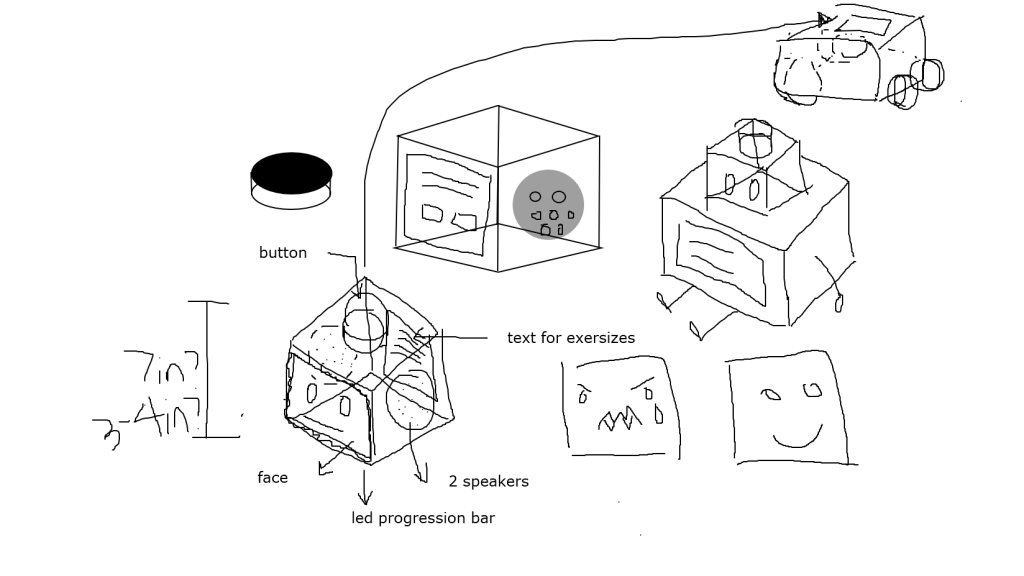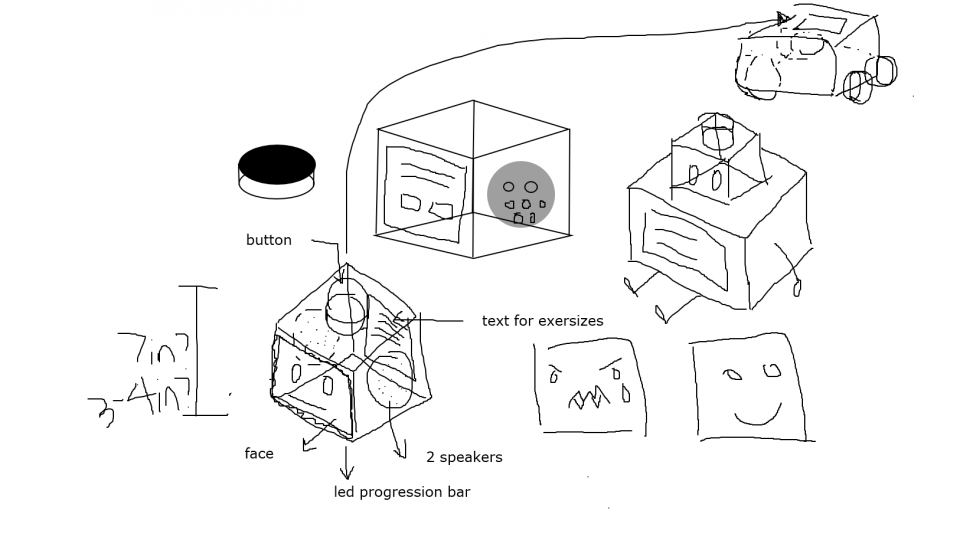
We were not able to take an image with Fredrick, but this is a sketch of a potential device that he found interesting
Introduction
For our project, we want to create a device for an elderly person that would pertain to them specifically and help them resolve some problem existing in their life or will bring more positivity for them. Our participant is Fredrick, and we were able to schedule an interview with him to first get an idea of who he is and the problems that he may have in his life. Our team consists of Patricia, Aadya, and Z (team Exercise Companion) and we had a great first conversation with Fredrick on March 24th.
To listen to our full interview: Click here
Meeting Agenda
To plan for the structure and content of our interview, we created a shared Google document.
Introduction
- Hi, Frederick. How is everyone doing today?
- Thank you Frederick for meeting with us remotely today, it is a challenging time for everyone and we very appreciate your presence today. May I record this interview for documentation purpose?
- I’m …, I’m a (school year) student major in …. I like to ….. in the spare time. But I don’t like …. In the last project of making our own assistive device, I made a …. That help me … .
- Would you like to share a little bit about yourself as well? What do you like to do? What do you don’t like?
- What drew you to want to participate in this project? What would you like to get out from participating this project?
Explanation and clarification about project goals
Let me explain a little more about what we are going to do. Please let me know at any time when you have any question.
- We are:
- Trying to build prototype useful devices
- Engaging in an iterative design process, including gathering formative feedback around the midpoint of the process
- Taking about six weeks to go from this meeting to a reasonably high-fidelity final product
- Documenting our process
- Capable of simulating somewhat complex electronics via Tinkercad, and more complex physical objects/devices via CAD software
- We are not:
- Professional technologists who are experienced in making polished products
- Planning to build something that will be sold commercially
- Constrained by any practicality outside of usefulness to the person we’re designing for
- Likely to invent a totally novel piece of electronics (we combine many existing available components in new ways, but don’t make components)
- Give a quick timeline overview of the process
- Interview (between Monday March 23rd and Sunday March 29th)
- Ideation and convergence on an idea for prototyping (ideation sketches due in class Monday March 30th)
- Developing a prototype (Monday March 30th–Sunday April 5th)
- Presentation and critique of these prototypes (Monday April 6th)
- Elaboration/improvement/changes/finalization of the final project (weeks of April 13th and 20th)
- Final presentations and critique (Monday April 27th)
Understanding needs and thinking of possible technological interventions
In short, we would like to make a device that would be useful for your daily life. It can be something that help in daily activities that are difficult and frustrating. But it can also be something that’s a gadget that is fun and enjoyable to you.
- So, first of all, are there things that you already know that you really want to have that will help you a lot?
- Are there any activities in your daily life that are difficult, frustrating, or otherwise seem like you could use an intervention?
- You have mentioned that you enjoy …. a lot. Has it become harder with age? Is there any way to make it easier or more enjoyable?
- Imagine you have a device that can make anything more convenient, what would it be?
- What are some little things that make you happy in your daily life?
Things to remember during the conversation:
- why is this important to you?
- How about ….?
- Would it be better if you can ….?
Conclusion
Thank you for your time and we appreciate you to meet with us in short notice. We will try to communicate with you and make sure you are a part of the process as much as possible. This is our contact information and we look forward to talk to you again!
Meeting Summary
Our meeting with Frederick was very insightful and helped us learn about his daily routine and potential areas of assistance he might benefit from. First, we asked him about the hobbies he might have currently. He mentioned that he was getting into art but after some discussion, we didn’t find any evident reasons to provide assistance for him in this area. Next, spoke about his morning routine in which he reads multiple newspapers and wishes there was a way to consolidate all the news from various sources into one. We realized that the scope of that would be outside of this class.
He also described how he needs to constantly remind his wife to get the clothes from the washer after they are washed since the laundry unit is in the basement of his house and it is hard to know when the laundry cycle is complete. Although there was potential to design a persistent reminder that would remind his wife to get the clothes, as a group we decided that it would be best to design the assistive device for Frederick specifically.
After asking a few more questions about his daily routine we learned that he does yoga and stretching every day. He said that going through the exercise routine every day in the same order gets monotonous and boring. We thought that this could be a potential area where we could intervene and create something for him that would make his exercise routine more enjoyable. He said:
The goal would be to vary order of exercise with prompts for next exercise;
Following this meeting, he emailed us his stretching routine with all the exercises he goes through which was a very useful piece of information for us to begin ideating.
Thoughts After Our Meeting
After our meeting with Fredrick, we discussed as group and reflected over the information that we had gotten from the interview. People said that they were happily surprised by how open and talkative Fredrick was. He would think of different problems on his own and try to think of ways that he could help our project, for example, what types of problems would be feasible to actually create a device for.
We had planned out the structure of the interview beforehand and the different questions to ask him and everything went according to plan. We introduced ourselves in the beginning and explained our project carefully to him, he did not have many questions for this part, but stated that what we were doing was very interesting and he was happy to help.
With our list of questions, we were able to get a good idea of where the direction of our device could go. As we were talking with Fredrick we consistently gave our ideas on what we could do and see his reactions to each brainstorm. He was very helpful in the feedback where he had strong opinions on what he wanted and what was doable for us. Also, listening to his responses to our different ideas, we realized that Fredrick is a very practical man and enjoys the things that are simple but effective. He generally liked the devices that did not have multiple different features going on and preferred devices that were beneficial to his life rather than just for fun. This was the reason that we landed on our final decision to create the exercise companion device.
Next time in conducting interviews, we would be sure to call the person first to set an interview time, because that is the most effective way to get connected to a person. Then, email them as a backup plan if the phone call does not go through. This is because Fredrick did not respond to our initial email and during our interview he explained that he rarely checked his emails.


Comments are closed.